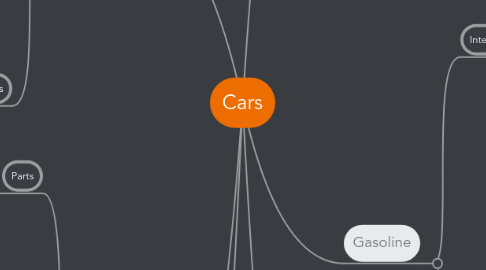
1. Electric
1.1. How they work
1.1.1. Batteries
1.1.1.1. Plug in Charging
1.1.1.2. Kinds of charging
1.1.1.2.1. Trickle charge
1.1.1.2.2. Rapid charge
1.1.2. Electric Motor
1.1.3. Regenerative braking
1.2. Pros
1.2.1. Can be zero-emissions
1.2.1.1. Depends on where the electricity comes from
1.2.2. 80% effient
1.2.3. Instant torque
1.2.4. No transmission
1.3. Tesla Model S
1.3.1. $1,048 annual fuel cost (30K miles)
1.3.2. Annual fuel cost of a gasoline car is 5,300 (30K miles) (Gas price of $3.90)
1.3.3. Tesla P85d vs. Ferrari 458 drag race
1.4. Cons
1.4.1. Batteries
1.4.1.1. Limited range
1.4.1.1.1. Range 80 miles (Nissan Leaf)- 300 miles (Tesla)
1.4.1.2. Metals and ions that go into the battery
2. Hybrid
2.1. "Ordinary" hybrid
2.1.1. Only charge via regenrative braking
2.2. Plugin hybrid
2.2.1. Charges over night (like a normal electric car)
2.2.2. Also charges with regenerative braking
2.3. How they work
2.3.1. Regular braking
2.3.1.1. Energy is all wasted
2.3.1.1.1. Brake dust
2.3.1.1.2. Heat
2.3.1.1.3. Sound
2.3.2. Regenerative braking
2.3.2.1. Generator
2.3.2.1.1. Connected to wheels via drivetrain
2.3.2.2. How to best break for effiencieny
2.3.2.2.1. Slamming on the brakes does not make more energy!!
2.3.2.2.2. To bring the vehicle to a stop you need "friction braking"
2.3.2.2.3. Regenerative breaking turns
2.4. Cons
2.4.1. Heavier
2.4.2. More exspensive
2.4.3. Battery issues
3. Fuel Cell
3.1. Parts
3.1.1. Hydrogen storage tank
3.1.2. Electric motor
3.1.3. Battery
3.1.4. Power control module
3.1.5. Fuel cell converter
3.2. How it works
3.2.1. Electrochemical cell
3.2.2. Membrane
3.2.2.1. Hydrogen is split apart into proton and electron
3.2.2.2. Proton passes through membrane
3.2.2.3. Electron can't pass so it goes through and is redirected through engine and back to the other side of the membrane
3.3. Pros
3.3.1. Only releases steam
3.3.1.1. Zero emissions
3.3.2. Toyota is sharing their information
3.3.2.1. They have pattens much of fuel cell tech
3.3.2.2. Releasing info to public and other corporations
3.4. Cons
3.4.1. Elon Musk thinks "hydrogen fuel cells are silly"
3.4.1.1. Hydrogen is not a fuel source but a fuel storage system
3.4.1.2. Hydrogen is hard to produce, store and use
3.4.2. Electrolysis
3.4.2.1. Split water into H and O
3.4.2.2. Very exspensive
3.4.2.3. Uses a lot of energy
3.4.2.3.1. 1/2 as effient as
3.4.2.4. Needs be liquified or compressed
3.4.3. Super flammable
3.4.4. Impossible to tell if its leaking
4. Natural Gas Vehicle (NGV)
4.1. Liquefied Natural Gas (LNG)
4.1.1. Cryogenic
4.1.1.1. Dispensed at 20 DGE/min
4.1.2. Can be vaporized on to CNG
4.1.2.1. Some fuel stations can provide CNG and LNG
4.1.3. Much cheaper to dispense
4.2. Compressed Gas Vehicle (CGV)
4.2.1. Pressurized to 3,000-6,000Psi
4.2.2. City bus systems
4.2.3. More exspensive infrastructure to dispense and store
4.2.4. Fueling
4.2.4.1. Traditional (at home)
4.2.4.1.1. .4GGE/hour
4.2.4.2. "Fast-Fill"
4.2.4.2.1. 10GGE/5-10min
4.2.4.2.2. Uses 100 times more electricity
4.3. Enviromental impact
4.3.1. 50-60% less Carbon Dioxide than coal and oil
4.3.2. 33% of GHG emissions from natural gas
4.3.3. Unburned methane is mostly methane
4.3.3.1. Leaks in transmission distribution
4.3.3.2. 21 GWP (global warming potential)
4.3.3.3. 12 years lifetime
4.3.3.4. Study found that if 3% of methane from NG escapes you would be better off burning coal
4.3.3.5. "Gangplank" to zero-emissions
4.3.3.6. By 2015 EPA will establish requirements for new methane wells
5. Gasoline
5.1. Internal Combustion
5.1.1. Recent trends
5.1.1.1. Smaller engines
5.1.1.1.1. Average engine size in Europe 1.6L, USA 3.6L
5.1.1.2. More effient drivetrains
5.1.1.3. Transmissions with more gears
5.1.1.4. Performance created from more sophisticated engineering instead of larger engines
5.1.2. Factors that affect mpg
5.1.2.1. Engine size
5.1.2.2. Drivetrain
5.1.2.3. Service interval
5.1.2.3.1. Tires
5.1.2.3.2. Oil
5.1.2.3.3. Air filter
5.1.2.4. Transmission
5.1.2.5. Vehicle weight
5.1.2.6. Using electronics at maximum
5.2. Hight of efficiency
5.2.1. Cheapest most economical vehicle
5.2.1.1. Honda Insight
5.2.1.1.1. Integrated Motor Assist
5.2.1.1.2. 41City/44Highway
5.2.1.1.3. $19,500 starting price
5.2.1.2. Nissan Versa S Plus
5.2.2. Cars under $30,000 that get 30mpg
5.2.2.1. Chevy Cruze
5.2.2.2. Fiat 500 Pop
5.2.2.3. Ford Fiesta SE
5.2.2.4. Honda Accord LX
5.2.2.5. Volkswagen Jetta
5.2.3. Still, only 30% of energy put into an engine goes to turning the wheels
6. Diesel
6.1. Internal combustion
6.2. Pros
6.2.1. Better mpg
6.2.1.1. 33% times more efficient that gas
6.2.2. More energy stored within the bonds of diesel
6.2.3. Less CO2 per mile
6.2.4. Save an average of $2,000 annually on fuel
6.3. Cons
6.3.1. Engines are more exspenisve to build
6.3.1.1. High compression
6.3.1.2. No spark plugs
6.3.2. Harder to ignite
6.3.3. 20 cents more than unleaded gas (per gallon)
6.3.4. More NOx and PMs
